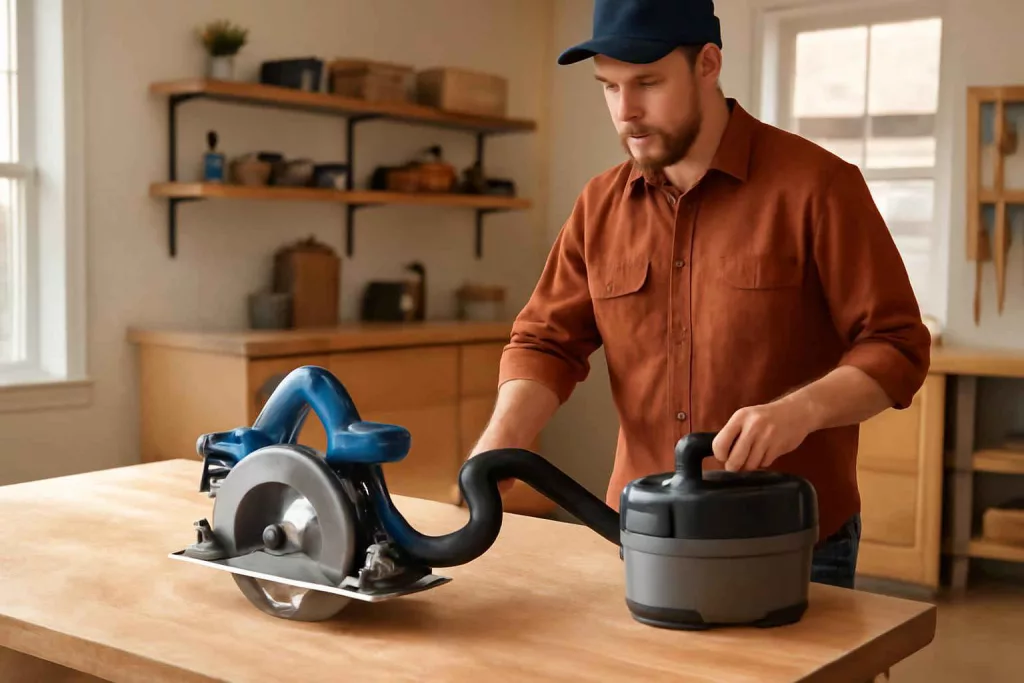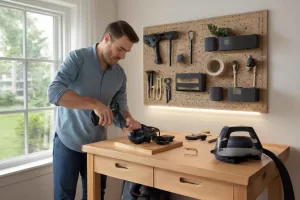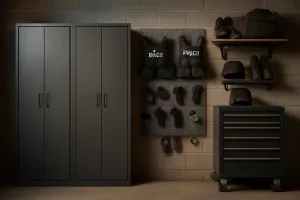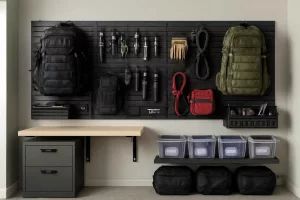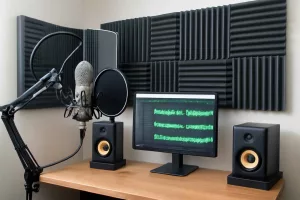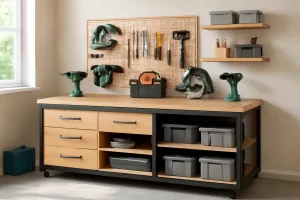Fine dust from power tools not only makes cleanup tedious but also poses serious health risks when inhaled. A high-quality portable dust extractor is essential for any home workshop, capturing sawdust, drywall particles, and other debris right at the source. Whether you’re running a cordless circular saw or a handheld sander, investing in a compact unit can drastically improve air quality and extend the life of your tools. You can explore top-rated options on Amazon to find the best portable dust extractor for your needs: shop portable dust extractors.
Why Invest in a Portable Dust Extractor
Workshops and garages quickly fill with airborne particles during cutting, sanding, and routing tasks. Without proper dust control, small particles settle on surfaces, infiltrate tool motors, and circulate in the air you breathe. A portable dust extractor tackles these issues at the source, capturing debris through powerful suction and high-efficiency filters. Here are the main reasons every DIY enthusiast should consider one.
Health and Safety Benefits
Breathing in fine wood dust or silica from masonry work can cause long-term respiratory problems, including asthma and silicosis. Portable dust extractors equipped with HEPA filters remove up to 99.97% of particles down to 0.3 microns. This level of filtration significantly reduces airborne hazards, helping you maintain a safer workspace and protect your lungs during extended projects.
Tool Performance and Workshop Cleanliness
Accumulated dust clogs vents, impedes airflow, and accelerates wear on sanding pads and cutting bits. By attaching a dust extractor to your tools, you prevent buildup around bearings and motor brushes, prolonging the lifespan of your equipment. Additionally, capturing dust at the source keeps work surfaces clear, reducing cleanup time and ensuring precise cuts and smooth finishes every time.
Key Features to Look for in a Portable Dust Extractor
Not all dust extractors are created equal. To choose the right compact unit, evaluate these critical features:
Suction Power and Airflow (CFM)
Measured in cubic feet per minute (CFM), airflow rating indicates how much debris the unit can move. Higher CFM machines excel at capturing heavy dust loads, especially when connected to table saws or routers. However, high CFM often comes with increased weight and noise, so balance performance with portability based on your most common tasks.
Filter Type and Efficiency
Look for extractors with multi-stage filtration systems, including pre-filters for large particles and HEPA filters for fine dust. Washable filters lower long-term costs, but require regular maintenance. Replaceable HEPA cartridges ensure the highest filtration efficiency, critical for woodworking and cutting concrete or stone.
Portability and Weight
A lightweight design under 20 pounds ensures you can move the extractor around a mid-sized garage or workshop without strain. Integrated handles, wheels, or backpack-style straps make transportation between job sites easier. If you operate mostly indoors, prioritize compact footprint over heavy-duty features.
Hose Compatibility and Accessories
Universal couplers and varied hose diameters let you attach the extractor to multiple power tools. Check if the unit includes adapters for 1″, 1.25″, or 2″ dust ports. Accessories such as floor brushes, crevice nozzles, and extension hoses expand its versatility, letting you clean workstations and nooks in addition to tool dust ports.
Noise Level
Workshops often echo the roar of equipment, so quieter extractors (below 70 dB) help prevent hearing fatigue. Many models feature variable-speed controls to dial back suction—and noise—when capturing light dust from finishing work or when neighbors are nearby.
Top Portable Dust Extractors for Power Tools (2024 Guide)
We’ve researched dozens of compact dust extraction units to bring you these top picks, balancing performance, portability, and price. Each model works seamlessly with popular power tools and includes filters and adapters for immediate use.
1. Makita XCV11Z 18V LXT® Built-In 2-Stage Suction Portable Dust Extractor
The Makita XCV11Z pairs with 18V LXT® batteries to deliver 66 CFM airflow and 2-stage filtration, capturing both large chips and fine dust. Weighing under 10 pounds without a battery, it offers exceptional portability. The adapter accepts 1-1/4″ hoses, and the detachable handle doubles as a stand for wall-mount storage. Perfect for framing nailers, grinders, and small saws.
2. DEWALT DCV517M1 20V Max Cordless/Corded Dust Extractor
With both battery and corded operation, the DEWALT DCV517M1 offers up to 85 CFM airflow and a 2.5-gallon tank capacity. The HEPA-rated filter traps 99.97% of 0.3-micron dust, and onboard accessory storage keeps adapters and fittings organized. The anti-static hose reduces dust cling, simplifying cleanup after prolonged use.
3. Festool CT MINI / CT MIDI Compact Dust Extractor
Festool’s CT MINI and CT MIDI models feature variable suction control, automatic tool-triggered operation, and an airtight system to maintain consistent performance. The CT MINI offers 29 CFM in a 6.6-pound package, while the CT MIDI boosts airflow to 55 CFM with a 5-gallon tank. Ideal for precise finishing applications and heavy-duty routing tasks.
4. Bosch GAS18V-02N 18V Cordless UniversalVac™ 2.5 Gallon Dust Extractor
The Bosch GAS18V-02N is a 2.5-gallon dust extractor delivering 77 CFM airflow. It features CleanSystem filter cartridges for easy maintenance and a self-cleaning filter-shake function. With a rugged roll cage design and multiple docking options on compatible Bosch power tools, this unit excels in both workshop and jobsite environments.
5. Metabo HPT RP0360FC MultiVolt Wet/Dry Dust Extractor
Metabo HPT’s RP0360FC MultiVolt extractor supports both 36V and 18V platforms, producing 100 CFM airflow and accepting wet or dry debris. The included telescoping handle and on-board accessory storage make it a versatile choice for remodeling, tile cutting, and general workshop cleanup. The washable HEPA filter reduces operating costs over time.
How to Use and Maintain Your Portable Dust Extractor
Maximizing performance and extending the life of your dust extractor relies on proper setup and maintenance. Follow these best practices to keep suction strong and filters functioning at peak efficiency.
Proper Setup and Connection
1. Choose the right adapter for your power tool’s dust port. 2. Position the extractor close to your tool, keeping hoses straight without kinks. 3. Ensure the filter cage is securely in place before powering on. 4. Use automatic tool-start functions if available to synchronize the extractor with tool operation.
Routine Filter Cleaning and Replacement
Remove and shake out pre-filters weekly during heavy use. Washable filters should be cleaned according to manufacturer instructions and fully dried before reinstalling. Replace HEPA cartridges annually or when suction noticeably decreases, as clogged filters strain the motor and reduce performance.
Storage and Portability Tips
After each session, drain any wet debris and remove hoses to prevent mold or odor buildup. Use integrated hose wraps or onboard accessory holders to keep everything together. For mobile jobs, secure the unit on a cart or mount it on the back of a rolling tool chest. You can store hoses efficiently with an under-bench vacuum hose holder to free up floor space.
Frequently Asked Questions
Do I need a HEPA filter in my portable dust extractor?
Yes. HEPA filters remove the finest particles and allergens, safeguarding your health and preventing dust recirculation. Always choose HEPA-rated units for woodworking and concrete cutting.
Can I use a regular shop vacuum instead of a portable dust extractor?
While shop vacuums are cheaper, most lack certified HEPA filtration and lose suction quickly. Portable dust extractors offer stronger, consistent airflow and specialized filters designed for fine dust handling.
How often should I empty the dust container?
Empty containers when they reach 75% capacity to maintain maximum airflow. Overfilling can clog filters and overwork the motor.
Are cordless dust extractors as powerful as corded models?
Cordless extractors have improved significantly, now offering up to 100 CFM in some models. However, corded units typically deliver the highest sustained airflow for heavy-duty applications.
Conclusion
Portable dust extractors are indispensable for DIYers and professionals alike, ensuring clean air, safer workspaces, and longer-lasting tools. From ultra-light cordless units like the Makita XCV11Z to heavy-duty models like the Metabo HPT RP0360FC, there’s a dust extraction solution for every workshop size and task. Ready to upgrade your dust control? Browse current deals on Amazon: find the perfect dust extractor. For a budget-friendly, permanent system build, also check our guide on the DIY Cyclone Dust Collector.
